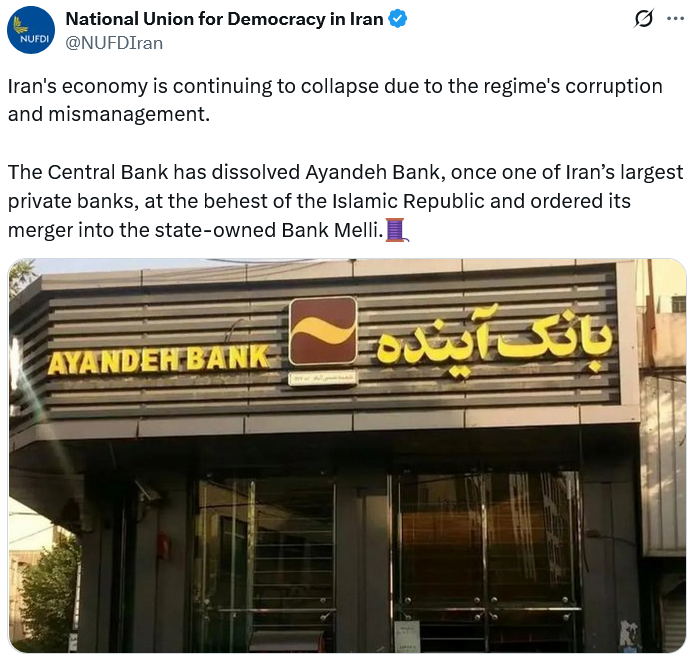Iran’s Ayandeh Bank has declared bankruptcy after accruing $5.1 billion in losses and $3 billion in debt, leading to its dissolution and the transfer of over 42 million customer accounts to state-owned Bank Melli. This event underscores ongoing vulnerabilities in Iran’s banking sector amid sanctions, potentially boosting interest in decentralized alternatives like Bitcoin.
-
Ayandeh Bank bankruptcy highlights risks in fractional reserve banking systems.
-
Over 42 million customers’ assets are now managed by Bank Melli Iran following the closure of 270 branches.
-
The incident echoes global banking crises that have historically driven Bitcoin adoption, with Iran’s sanctions exacerbating local financial instability.
Iran’s Ayandeh Bank bankruptcy shakes the financial landscape, absorbing $8 billion in losses into Bank Melli. Explore crypto’s role as a hedge against such banking failures. Stay informed on global finance trends today.
What is the Impact of Ayandeh Bank Bankruptcy on Iran’s Economy?
Ayandeh Bank bankruptcy represents a significant collapse in Iran’s private banking sector, where the institution accumulated approximately $5.1 billion in losses and nearly $3 billion in debt before its dissolution. This failure, declared on Thursday, affects more than 42 million customers whose accounts and assets have been transferred to the state-owned Bank Melli Iran. The Central Bank of Iran attempted a rescue but ultimately closed the bank’s 270 nationwide branches, highlighting systemic fragilities exacerbated by international sanctions.
How Do Sanctions Contribute to Banking Instability in Iran?
International sanctions have severely restricted Iran’s access to global financial networks, limiting U.S. dollar transactions and increasing operational risks for local banks. As reported by Iran International, these pressures have devalued the Iranian rial, eroding public confidence in traditional banking. The Central Bank of Iran has warned that eight other banks face similar dissolution risks without immediate reforms, according to earlier statements from the institution. Expert analysts, including those cited in financial reports from Reuters, note that such constraints force banks into unsustainable lending practices, mirroring broader economic strains. For instance, customer deposits are often lent out under fractional reserve systems, leaving institutions vulnerable to defaults. In Iran’s case, this has led to a cascade of failures, with Ayandeh Bank’s closure serving as a stark example. Data from local economic updates indicates that the banking sector’s non-performing loans have surged by over 20% in recent years due to these external factors. Financial experts emphasize that without lifting sanctions or implementing robust domestic policies, further collapses are likely, potentially displacing millions more in savings.

Source: National Union for Democracy in Iran
The Central Bank of Iran Governor Mohammad Reza Farzin has assured affected customers that they can access their savings promptly through Bank Melli, yet the event raises broader questions about the reliability of centralized financial systems. It parallels historical banking crises that have influenced the development of decentralized finance solutions.
Frequently Asked Questions
What Caused the Ayandeh Bank Bankruptcy in 2025?
The Ayandeh Bank bankruptcy stemmed from $5.1 billion in accumulated losses and $3 billion in debt, as detailed in reports from Iran International. Failed rescue efforts by the Central Bank of Iran led to its dissolution, impacting 42 million customers and closing 270 branches across the nation.
How Might Ayandeh Bank Bankruptcy Affect Crypto Adoption in Iran?
The Ayandeh Bank bankruptcy could accelerate interest in cryptocurrencies like Bitcoin among Iranians seeking alternatives to unstable banks. With sanctions limiting traditional finance, Bitcoin’s decentralized nature offers a hedge against local currency devaluation and banking failures, as seen in past global crises where Bitcoin prices rose amid trust erosion in fiat systems.
Key Takeaways
- Fractional Reserve Risks: Ayandeh Bank’s collapse illustrates the dangers of banks lending out customer deposits without full reserves, often requiring government bailouts.
- Sanctions’ Role: International restrictions have crippled Iran’s banking access to global markets, contributing to the rial’s decline and heightened default risks.
- Crypto Relevance: Events like this reinforce Bitcoin’s origins as a response to banking failures, potentially driving adoption in sanctioned economies as a secure alternative.
Conclusion
The Ayandeh Bank bankruptcy marks a pivotal moment in Iran’s fragile financial landscape, where sanctions and banking instability have forced the dissolution of a major private lender and the absorption of vast customer assets into Bank Melli. This development not only affects 42 million individuals but also spotlights the enduring appeal of Bitcoin and cryptocurrencies as resilient options against centralized system failures. As Iran’s economy navigates these challenges, observers anticipate increased exploration of decentralized finance to safeguard wealth. Investors and individuals alike should monitor these shifts, considering diversified strategies that include digital assets for long-term stability.
